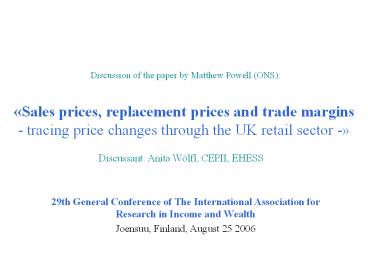- PowerPoint PPT Presentation
Title:
1
Sales prices, replacement prices and trade
margins- tracing price changes through the UK
retail sector -
Discussion of the paper by Matthew Powell (ONS)
Discussant Anita Wölfl, CEPII, EHESS
- 29th General Conference of The International
Association for Research in Income and Wealth - Joensuu, Finland, August 25 2006
2
Why looking at retail sale prices and margins
- Wholesale and retail trade is an important
sector - UK wholesale and retail trade accounts for about
10 in total production, - Retail prices are the source of most consumer
prices. - Main area of problems of price measurement
- Current practice assume a direct relationship
between sales and retail price indices, ... - an assumption which is not necessarily true,
... - and disregards changes in the quantity/ quality
of retail services themselves.
3
Implicit Value added deflators, wholesale and
retail trade - total economy is 100 -
Source OECD STAN Database 2002
4
A good start - the paper setup ...
- Step 1 Definition of margins and its discussion
- Step 2 Theoretical derivation of how to
construct margin volume indices - Step3 Formal discussion of how margin volume
indices are estimated in practice and the biases
that may result from it - Step 4 Empirical analysis
- pattern of different price indices and deflated
margins using these deflators - regression analysis of the role of products sold
versus retailers for margins - Step 4 Conclusion and implications
5
but room for improvement in the detail
- The style of the paper
- the reader matters,
- precision, detail, clarity, ...
- The line of argumentation
- What are the points raised?
- Are these thoroughly discussed in the theoretical
and empirical analysis? - What about alternatives?
- gt Discussion by presenting the paper in more
detail
6
What are trade margins?
- Definition in the SNA (1993)
- Trade margin the difference between the actual
or imputed price realized on a good purchased for
resale and the price that would have to be paid
by the distributor to replace the good at the
time it is sold or otherwise disposed of. - Raises three issues
- not necessarily a proportional relationship
between sales price index and constant price
margins, instead difference between two prices
gt double deflation preferable? - replacement price matters and not the price
that a retailer actually paid for purchasing the
good gt existence of a price pipeline? - margin price of the retail service gt
measurable as such?
7
How to compute the volume index of trade margins?
I
- Based on volume index of sales
- volume index of margins index of sales volumes
weighted by base period margin values. - way in which margin volumes are computed in
practice - Based on double deflation
- volume index of margins difference between
current sales deflated to the base period sales
and current replacement costs deflated to base
period replacement costs - theoretically closest to the definition in SNA
8
How to compute the volume index of trade margins?
II
- Argumentation in the paper
- Both ways to estimate margin volumes may be
subject to biases. - Extend of biases depends on
- covariance between the current price margin and
the resale quantity index - covariance between resale/replacement price and
quantity index. - Double deflation better extra bias arising from
the use of sales weighted indices as opposed to
margin weighted indices. - Which way would create smaller bias is then an
empirical question. - Questions
- Is it really the sales weighted versus the
margin weighted that is relevant, or the lack
of consideration of changes in the margins over
time/ real margin index? - Bias judged to which reference?
9
What do the data say ? I
- The data
- Retail Sales index (RSI) ONSs survey of retail
activity - monthly turnover inquiry for 27 NACE groups
- deflators for 44 different COICOP groups,
calculated with data from the Retail Price Index
(RPI) - Annual Business Inquiry (ABI) 2000
- Questions
- RSI makes no attempt to measure double deflated
trade margins or to measure replacement costs. -
how are replacement costs estimated in this
analysis? - Data comparability ?
10
Diverging pattern of sales and replacement cost
deflators
Source Based on data in Powell (2006)
11
and their impact on deflated margins
Source Based on data in Powell (2006)
12
What do the data say? II
- Correlations and regression analyses
- current price margins are positively correlated
with growth in quantities deflated by
sales/replacement deflator - sales/replacement price deflators are - to a
similar extent - negatively correlated with
growth in respective quantities. - not the products sold matter most for determining
current or constant margins, but the firms who
sell them. - Argumentation
- The results would speak against estimating margin
volumes based on sales volume indices only and
against the existence of a price pipeline - gt double deflation would be preferable
- paradox current price margins grow despite the
stronger growth in replacement prices than in
sales prices.
13
What do the data say? II
- Discussion
- Not necessarily paradox depends on difference
in relative level and development of resale and
replacement price indices. - Empirical results may speak against sales based
margin volumes, - but do not necessarily favour double deflation
as the better alternative - Theory versus practice once more (data needs,
complex estimation of replacement costs) - Also double deflation is based on price indices
of the goods purchased and sold - What about a real price index for the retail
service?































